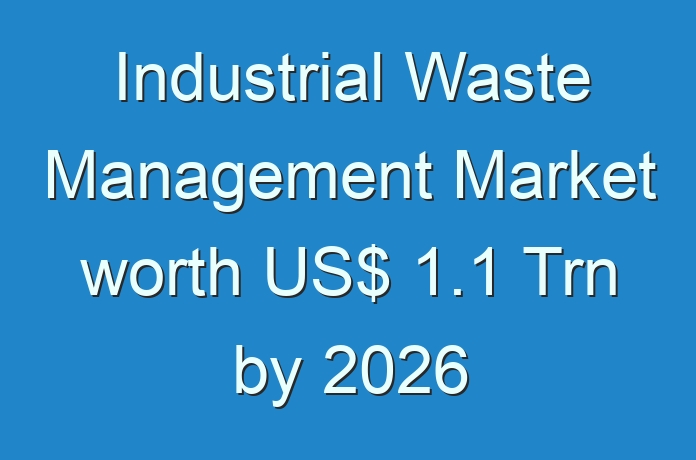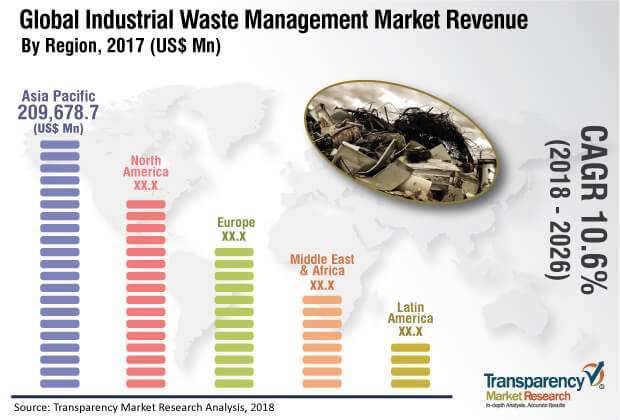
Industrial Waste Management Market – Snapshot
Industrial waste is a combination of solid, liquid, and gaseous waste generated and collected from various industries such as construction, oil & gas, chemical, nuclear, agriculture, and mining. It is a combination of hazardous and non-hazardous waste. Chemical, oil & gas, and nuclear industries constitute the major share of the hazardous industrial waste generated each year.
Rapid industrialization followed by stringent regulations on dumping of thermal power plant waste to boost market
Industrial waste constitutes approximately 50% share of the overall waste generated across the globe. Rapid industrialization and rise in population are expected to generate high industrial waste in the next few years. Several service providers are entering the industrial waste management business owing to the high potential coupled with government support and funding. Coal combustion products (CCP) contain environmentally hazardous contaminants such as arsenic, cadmium, and mercury. If not monitored properly, these substances can cause serious threat to the environment. Therefore, it is vital to regulate the disposal of CCPs such as fly ash through coal-fired power stations. Regulatory authorities across the globe such as the U.S. EPA and the European Union’s waste legislation regulate the disposal of industrial waste. In October 2016, the U.S. EPA issued a set of rules for safe disposal of coal combustion products in the U.S.

Expanding operations in future? To get the perfect launch ask for a custom report
Growth in concerns about proper treatment and disposal of hazardous industrial waste
Hazardous industrial waste constitutes less than 4% share of the global industrial waste market. However, collection, treatment, and disposal costs of hazardous industrial waste are 10 times higher than that of non-hazardous industrial waste.
Nuclear, oil & gas, and chemical industries are dominant producers of hazardous waste. These industries are projected to generate even more waste in the next few years owing to the high demand for energy and chemical products across the globe. This is likely to benefit service providers engaged in collection, treatment, and disposal of hazardous industrial waste. Technical expertise, prior experience of handling hazardous waste, and adherence of government norms are primary factors that determine the contract for hazardous industrial waste management among service providers.
Developed nations are more active in industrial waste management
Countries in Europe and North America have enacted stringent regulations pertaining to collection, recycling, landfill, and incineration of industrial waste. Countries and sub-regions in Asia, especially India, China, and ASEAN, are beginning to shift toward sustainable industrial waste management. However, several developing and under-developed nations in Middle East & Africa and Latin America are struggling to implement regulations on collection, recycling, landfill, and incineration of industrial waste. This is estimated to hamper the demand for industrial waste management, especially in Middle East & Africa and Latin America, in the near future.
More Trending Reports by Transparency Market Research – https://www.prnewswire.com/news-releases/global-solar-street-lighting-market-to-reach-a-valuation-of-us-12-54-bn-by-2027-the-renewable-energy-movement-to-drive-solar-street-lighting-market-finds-tmr-301028795.html
Developments & innovations in terms of product and technology in industrial waste management market
In October 2018, Waste Management Inc. received ‘Highest Scores in Industry’ on the 2018 Dow Jones Sustainability Indices (DJSI) North America and World. In October 2018, the company opened its solids and liquids injection disposal facility in West Texas, the U.S., in order to serve the oil & gas industry. In 2017, Waste Management Inc. generated revenue of US$ 9.2 Bn through collection of wastes. In 2017, landfill constituted 41.6% of the waste managed by the company, followed by transfer (19%) and recycling (17.7%). In November 2013, Waste Management Inc. signed a contract with American Electric Power (AEP) to provide landfill management and fly ash marketing services at the three power plants in Texas, the U.S. In May 2018, Sembcorp Industries sold its medical waste treatment division to TEE Medical Services for US$ 20 Mn. The division specializes in the treatment and disposal of bio-hazardous and pharmaceutical wastes. Its new owner, i.e. TEE Medical Services, is a 50:50 joint venture between TEE Infrastructure and Asia Enviro Services. In August 2018, a draft permit was issued for Veolia’s Energy from Waste (EfW) facility in Hoddesdon, the U.K. The Hoddesdon plant is designed to process wastes of up to 350,000 tons every year. It has capacity of 33.5 MWe. In September 2018, Suez Environnement strengthened its presence in China by acquiring two new contracts in wastewater and waste management in the city of Changshu. The company bagged the operation and maintenance contract for the waste treatment plant in Jianghe Tianrong area, China. In September 2018, Suez Environnement announced plans to construct a new energy-from-waste plant in Stockton-on-Tees (County of Durham), the U.K., to manage household and commercial waste in North East of the country from 2024. The project is expected to cost US$ 173 Mn. In February 2018, Clean Harbors, Inc. completed the acquisition of Veolia’s U.S. Industrial Cleaning division, a subsidiary of Veolia Environmental Services, for approximately US$ 120 Mn. The acquisition helped the company offer industrial services of significant scale. It also helped the company expand its existing industrial services business in the U.S.
Asia Pacific market to grow at fast pace in terms of demand
Asia Pacific is the key region of the industrial waste management market. It is expected to remain dominant during the forecast period owing to the year-on-year increase in generation and collection of industrial waste. There exists significant potential to reduce industrial waste; reuse and recycle waste; achieve higher productivity and resource security; generate employment; and reduce risks to humans and ecosystems in Asia Pacific. China held major share of the industrial waste management market in Asia Pacific in 2017. It is one of the key importers of industrial and e-waste from the U.S. and Europe. However, demand for industrial waste management in India is projected to rise at a rapid pace during the forecast period. The Government of India has partnered with Innovate UK and Research Councils, the Biotechnology and Biological Sciences Research Council (BBSRC), and the Engineering and Physical Sciences Research Council (EPSRC) in projects that use cutting-edge solutions to reduce industrial waste.
Request Sample pages of premium Research Report – https://www.transparencymarketresearch.com/sample/sample.php?flag=B&rep_id=12290
Highly competitive market with dominance of top players
The global industrial waste management market is highly fragmented; large numbers of local and international players provide industrial waste management services. Leading players dominate the market. Key players operating in the industrial waste management market are Stericycle, Inc., Waste Management, Inc., Sembcorp Industries, Veolia, Suez, Reclay Group, Daiseki Co., Ltd., Enviroserv Waste Management (Pty) Ltd., Clean Harbors, Inc., and SA Waste.
Request for covid19 Impact Analysis – https://www.transparencymarketresearch.com/sample/sample.php?flag=covid19&rep_id=12290





